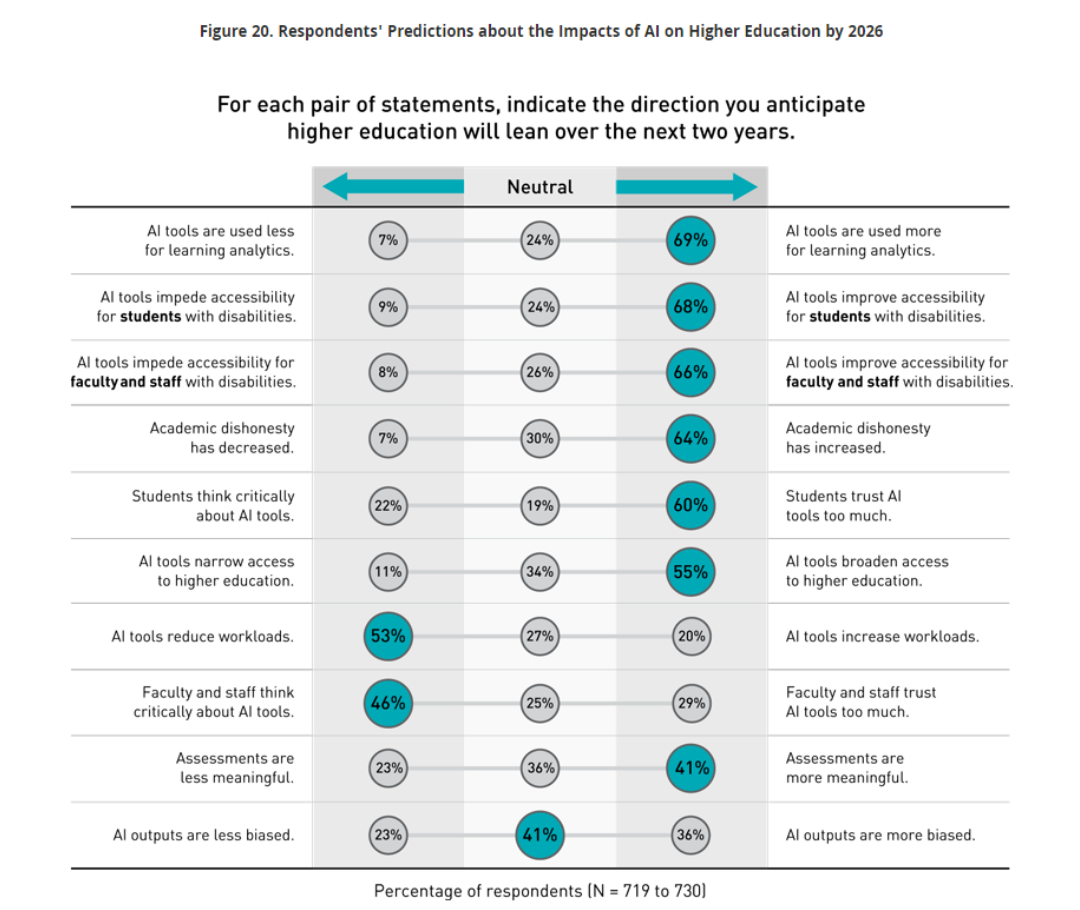As artificial intelligence (AI) continues to evolve, its integration into higher education is becoming increasingly significant. The 2024 EDUCAUSE AI Landscape Study sheds light on the future of AI in academic settings, highlighting both the potential benefits and the challenges that institutions face as they adapt to this transformative technology (EDUCAUSE, 2024).

Understanding Appropriate and Inappropriate Uses of AI
The higher education community is still grappling with the ethical implications of AI use. Respondents to the study emphasized the importance of transparency and ethical considerations in AI applications. Appropriate uses of AI in higher education include:
- Personalized Student Support: AI can enhance tutoring, academic advising, and administrative processes, making education more accessible.
- Teaching Assistance: AI can aid in course design, grading, and providing feedback to both students and faculty.
- Research Assistance: AI tools can help in literature review, data analysis, and predictive modeling.
- Administrative Support: Automating repetitive tasks can free up valuable time for educators and administrators.
- Learning Analytics: AI can analyze student success data to inform recruitment and retention strategies.
Conversely, inappropriate uses of AI include:
- Trusting AI Outputs Without Oversight: Relying solely on AI for grading or peer review can undermine academic integrity.
- Misrepresentation of AI-Generated Work: Using AI to produce work without proper citation is considered academic misconduct.
- Invasive Data Collection: AI should not be used for unauthorized surveillance or data collection.
Opportunities and Risks of AI in Higher Education
The integration of AI presents numerous opportunities for enhancing teaching, learning, and administration. Some of the key opportunities identified in the study include:
- Improving Student Engagement: AI can create personalized learning experiences that meet students’ needs in real time.
- Enhancing Research Capabilities: AI can analyze large datasets and generate insights that inform decision-making.
- Streamlining Administrative Processes: Automating mundane tasks can reduce workloads for faculty and staff.
However, these opportunities come with risks, such as:
- Ethical Concerns: Issues like plagiarism and bias in AI outputs can undermine the integrity of academic work.
- Privacy and Security: The potential for intrusive data collection raises concerns about student privacy.
- AI Literacy: A lack of understanding about AI tools can lead to misapplication and mistrust among students and faculty.
Real-World Applications of AI in Higher Education
Several universities in the US and Australia are already leveraging AI to enhance their recruitment processes and drive digital transformation. For instance:
1) INTO University Partnerships:
INTO has developed an AI-powered admissions service that significantly streamlines the recruitment process for international students. This innovative system reduces application processing time from weeks to just hours, processing over 30% of admissions within one hour. The AI technology reads and extracts data from application documents, ensuring compliance with admissions standards and providing detailed feedback to students and counselors (The PIE News, 2023). This approach not only enhances the efficiency of the admissions process but also supports universities in attracting talented international students.
2) University of Alabama at Birmingham (UAB):
UAB has partnered with INTO to utilize this new AI admissions service, which has significantly improved application turnaround time and efficiency. Kristin Brymer, the director of international admissions at UAB, noted that this innovative system enhances their ability to attract and enroll talented international students while ensuring a smooth and compliant admissions process (The PIE News, 2023).
These examples illustrate how universities are embracing AI to innovate their recruitment strategies and enhance their overall hiring processes, aligning with the broader trend of digital transformation in higher education.
A Cautiously Optimistic Future
Despite the challenges, the higher education community remains cautiously optimistic about the future of AI. Survey respondents predict that AI tools will increasingly be used for learning analytics (69%) and will improve accessibility for both students (68%) and faculty (66%) (EDUCAUSE, 2024). However, there is still work to be done in ensuring that institutions have the resources and knowledge to support the effective use of AI tools, particularly for individuals with disabilities.

Conclusion
The future of AI in higher education is filled with potential, but it is essential for institutions to navigate the associated risks carefully. By fostering a culture of ethical AI use and ensuring that all stakeholders are equipped with the necessary knowledge and resources, higher education can harness the power of AI to enhance learning experiences and improve administrative efficiency. As we move forward, collaboration and open dialogue will be key to shaping a future where AI serves as a valuable ally in the pursuit of educational excellence.



